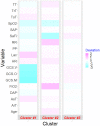Novel Prehospital Phenotypes and Outcomes in Adult-Patients with Acute Disease
- PMID: 35596887
- PMCID: PMC9123608
- DOI: 10.1007/s10916-022-01825-z
Novel Prehospital Phenotypes and Outcomes in Adult-Patients with Acute Disease
Abstract
An early identification of prehospital phenotypes may allow health care workers to speed up and improve patients' treatment. To determine emergency phenotypes by exclusively using prehospital clinical data, a multicenter, prospective, and observational ambulance-based study was conducted with a cohort of 3,853 adult patients treated consecutively and transferred with high priority from the scene to the hospital emergency department. Cluster analysis determined three clusters with highly different outcome scores and pathological characteristics. The first cluster presented a 30-day mortality after the index event of 45.9%. The second cluster presented a mortality of 26.3%, while mortality of the third cluster was 5.1%. This study supports the detection of three phenotypes with different risk stages and with different clinical, therapeutic, and prognostic considerations. This evidence could allow adapting treatment to each phenotype thereby helping in the decision-making process.
Keywords: Clinical Decision-Making; Clinical Deterioration; Clinical Phenotypes; Emergency Medical Services; Pre-hospital Care.
© 2022. The Author(s), under exclusive licence to Springer Science+Business Media, LLC, part of Springer Nature.
Conflict of interest statement
The authors declare no competing interests.
Figures




Similar articles
-
The Value of Prehospital Early Warning Scores to Predict in - Hospital Clinical Deterioration: A Multicenter, Observational Base-Ambulance Study.Prehosp Emerg Care. 2021 Sep-Oct;25(5):597-606. doi: 10.1080/10903127.2020.1813224. Epub 2020 Sep 15. Prehosp Emerg Care. 2021. PMID: 32820947
-
Prehospital troponin as a predictor of early clinical deterioration.Eur J Clin Invest. 2021 Nov;51(11):e13591. doi: 10.1111/eci.13591. Epub 2021 May 18. Eur J Clin Invest. 2021. PMID: 34002363
-
Derivation and validation of new prehospital phenotypes for adults with COVID-19.Emergencias. 2022 Oct;34(5):361-368. Emergencias. 2022. PMID: 36217931 English, Spanish.
-
Factors influencing the decision to convey or not to convey elderly people to the emergency department after emergency ambulance attendance: a systematic mixed studies review.BMJ Open. 2018 Aug 30;8(8):e021732. doi: 10.1136/bmjopen-2018-021732. BMJ Open. 2018. PMID: 30166299 Free PMC article.
-
Management of prehospital thrombolytic therapy in ST-segment elevation acute coronary syndrome (<12 hours).Minerva Anestesiol. 2005 Jun;71(6):297-302. Minerva Anestesiol. 2005. PMID: 15886591 Review.
Cited by
-
Clinical phenotypes and short-term outcomes based on prehospital point-of-care testing and on-scene vital signs.NPJ Digit Med. 2024 Jul 24;7(1):197. doi: 10.1038/s41746-024-01194-6. NPJ Digit Med. 2024. PMID: 39048671 Free PMC article.
-
Prehospital acute life-threatening cardiovascular disease in elderly: an observational, prospective, multicentre, ambulance-based cohort study.BMJ Open. 2023 Nov 23;13(11):e078815. doi: 10.1136/bmjopen-2023-078815. BMJ Open. 2023. PMID: 37996229 Free PMC article.
-
A Comparison of the Clinical Characteristics of Short-, Mid-, and Long-Term Mortality in Patients Attended by the Emergency Medical Services: An Observational Study.Diagnostics (Basel). 2024 Jun 19;14(12):1292. doi: 10.3390/diagnostics14121292. Diagnostics (Basel). 2024. PMID: 38928707 Free PMC article.
-
The use and impact of prehospital blood lactate measurements in acute non-traumatic patients: a systematic review.Scand J Trauma Resusc Emerg Med. 2024 Dec 26;32(1):137. doi: 10.1186/s13049-024-01310-1. Scand J Trauma Resusc Emerg Med. 2024. PMID: 39725991 Free PMC article.
References
-
- Holmberg M, Andersson H, Winge K, Lundberg C, Karlsson T, Herlitz J, et al. Association between the reported intensity of an acute symptom at first prehospital assessment and the subsequent outcome: a study on patients with acute chest pain and presumed acute coronary syndrome. BMC Cardiovasc Disord. 2018;18(1):216. doi: 10.1186/s12872-018-0957-3. - DOI - PMC - PubMed
-
- Shkirkova K, Saver JL, Starkman S, Wong G, Weng J, Hamilton S, et al. Frequency, Predictors, and Outcomes of Prehospital and Early Postarrival Neurological Deterioration in Acute Stroke: Exploratory Analysis of the FAST-MAG Randomized Clinical Trial. JAMA Neurol. 2018;75(11):1364–1374. doi: 10.1001/jamaneurol.2018.1893. - DOI - PMC - PubMed
-
- Patel R, Nugawela MD, Edwards HB, Richards A, Le Roux H, Pullyblank A, et al. Can early warning scores identify deteriorating patients in pre-hospital settings? A systematic review. Resuscitation. 2018;132:101–111. - PubMed
Publication types
MeSH terms
Grants and funding
LinkOut - more resources
Full Text Sources
Other Literature Sources
Medical

